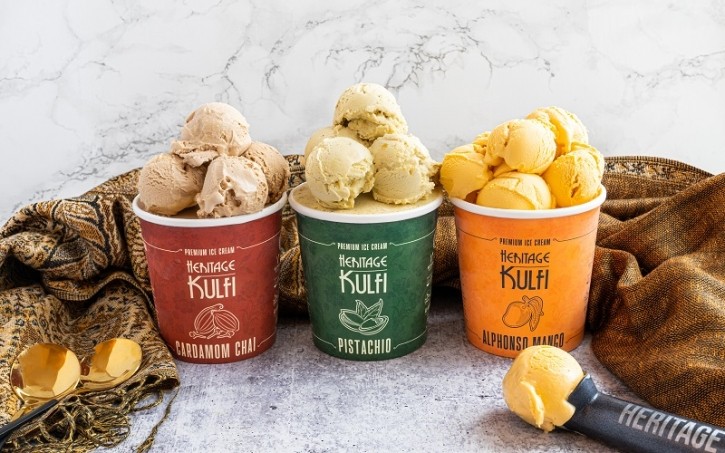Heritage Kulfi to bring nostalgic South Asian flavors to more ice cream aisles with KeHE ELEVATE program

“The inspiration for the brand is my own South Asian heritage and the kind of nostalgia for these variety of different ingredients that I grew up with and didn't see represented in the ice cream category. So having had some background in frozen distributions, some graphic design, some learning commercial ice cream making, I thought it'd be a great opportunity to launch something that's innovative and exciting in a category that is pretty sleepy.”
Bringing kulfi flavors to the US market for all to enjoy
Heritage Kulfi takes its name and inspiration from the frozen South Asian frozen treat kulfi, a denser-than-ice-cream frozen dairy dessert that would often be sold by street vendors and often include rose, mango, cardamom, and saffron flavors. And while many Asian frozen desserts have made their way to the US – from mochi to bubble tea-inspired desserts – Heritage Kulfi is the first brand to bring kulfi to the ice cream aisle, Ahmed claimed.
"This is the first time it's being done, and in that, it's a new experience for South Asians too. They've never had a rosewater ice cream or a saffron ice cream in a certain way. It's traditionally ... frozen on popsicles and kind of made in a very homemade style. So, not just building on that, it was very important for me to have that mainstream wide appeal."
And while Ahmed is looking to bring kulfi flavors to a wide audience, he's also aware of the trends happening in the ice cream market and is providing a clean-label ice cream product, including milk, cream, sugar, and the key ingredient(s) in the flavor. "The reason I want to do that is to give the kind of space for that ingredient to really shine, and that comes down to my formulation," he added.
And when it comes to formulating for ice cream, the brand faced several challenges because the flavor profile would change when it was a liquid mix and frozen, Ahmed admitted. Additionally, Heritage Kulfi formulated with "a variety of florals and teas and ingredients that are completely novel to the commercial ice cream world," which provided other challenges, he added.
Now with the formulation perfected, Ahmed is looking at the potential to launch into other ice cream sub-categories, including the plant-based ice cream category. While the plant-based ice cream market is seeing signs of growth, Ahmed is “aware of criticisms from a consumer standpoint around the various plant-based ice creams out there,” when it comes to taste and texture.
“I'm very excited because I feel like I have a formulation that had these flavors that maintain that same level of creaminess that you're expected from kulfi and that same flavor profile within that,” Ahmed said. “It is an expanding market, as well as the novelties, have been growing as well... so I do have plans to expand to that as well.”
Working with KeHE to grow brand
Beyond looking for opportunities to expand its portfolio, Heritage Kulfi will be making a big push into the Northeast and Midwest with the help of KeHE and its ELEVATE program, which provides retail resources for startups to help grow their brand. Currently, KeHE has 67 active suppliers in the category and 65 graduates, and brands typically see 170% more points of distribution on average because of the program, as shared in the announcement press release.
“They're a great group of people to work with, so to kind of have their support internally and to be able to build on that to hopefully within [these] two years be available nationally in different areas, is very exciting for a small emerging brand like [mine], and I'm hoping to kind of maximize on that opportunity.”
As part of its ELEVATE program, KeHE shares its "wealth of information" on retailers and works really directly with the brands to ensure they have the support that they need to succeed and expand in retail, Ahmed said. Additionally, KeHE category leaders will meet with brands in the ELEVATE program regularly to strategize what retailers they should approach and when to do so, he added.
And while the ultimate goal is to get into more retailers, building a great relationship with a distributor first is key, Ahmed said. “Much like in any CPG product, as much as you have a retailer who's interested in carrying it, it really doesn't mean anything if you don't have the distribution behind it to support it,” he added.
![[Video] Working with KeHE: What brands should know about securing a distribution deal](/var/wrbm_gb_food_pharma/storage/images/_aliases/wrbm_medium/publications/food-beverage-nutrition/foodnavigator-usa.com/news/suppliers/video-working-with-kehe-what-brands-should-know-about-securing-a-distribution-deal/17318576-2-eng-GB/Video-Working-with-KeHE-What-brands-should-know-about-securing-a-distribution-deal.png)




















